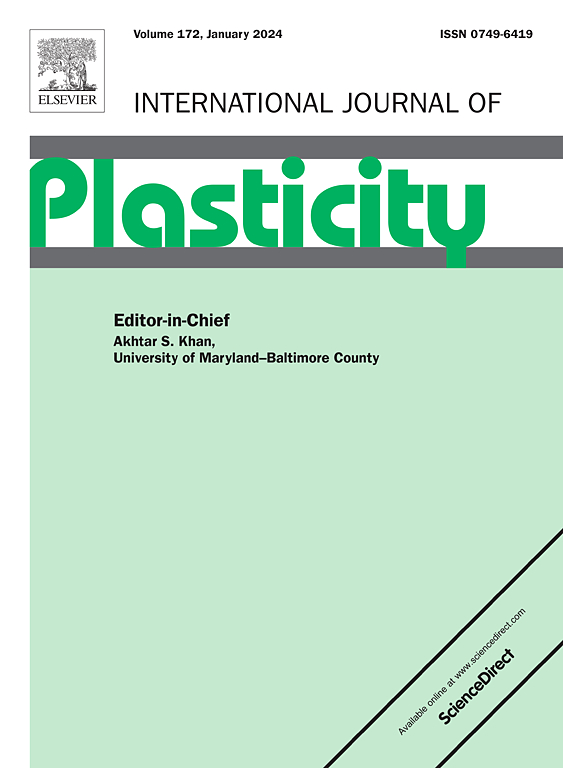建立并验证了用于动态再结晶模拟的非局部晶体塑性和概率元胞自动机的完全耦合模型
IF 9.4
1区 材料科学
Q1 ENGINEERING, MECHANICAL
引用次数: 0
摘要
本文提出了一种结合非局部晶体塑性有限元法(CPFEM)和概率元胞自动机(CA)的完全集成模型,以捕捉动态再结晶(DRX)过程中非均匀变形、形态演化和力学响应的耦合效应。所开发的模型结合了非局部方法,该方法考虑了几何上必要的位错(GND)和描述DRX微观结构演变的概率CA模型,两者都集成到处理多尺度非均匀变形的CPFEM公式中。基于周期性多晶网格作为有限元单元和CA单元,通过CPFEM计算了包括两种位错密度在内的晶粒级力学响应的非均匀分布。采用基于概率切换规则的CA模型,预测了DRX的微观组织演化与变形同步。然后将DRX引起的位错密度和结晶取向的变化反馈到CPFEM中,以确定随后的力学响应和塑性变形。通过对SA508-3钢热压粘接(HCB)过程的实验数据验证了该模型的有效性。结果表明,该模型有效地集成了DRX过程中宏观力学响应、中尺度位错密度分布和微观微观结构演化的预测。此外,通过适应相应的CA切换规则,该模型可以扩展到其他问题。本文章由计算机程序翻译,如有差异,请以英文原文为准。
Developing and validating a fully coupled model of non-local crystal plasticity and probabilistic cellular automata for dynamic recrystallization simulation
This study presents a fully integrated model combing non-local crystal plasticity finite element method (CPFEM) and probabilistic cellular automata (CA) to capture the coupled effect of heterogeneous deformation, morphological evolution and mechanical responses during dynamic recrystallization (DRX). The developed model incorporates a non-local methodology that accounts for geometrically necessary dislocations (GND) and a probabilistic CA model that describes DRX microstructural evolution, both of which are integrated into CPFEM formulations that handle multiscale heterogeneous deformation. Based on the periodic polycrystalline grids serving as both finite elements and CA cells, the non-uniform distribution of mechanical responses at grain-level, including two types of dislocation densities is calculated through CPFEM. The microstructural evolution of DRX, synchronized with deformation, is predicted through CA model with probabilistic switching rules. The DRX induced changes in dislocation densities and crystallographic orientation are then fed back into CPFEM to determine the subsequent mechanical response and plastic deformation. The proposed model is validated against experimental data for SA508–3 steel during hot compression bonding (HCB) process. It’s demonstrated that the proposed model effectively integrates predictions of macroscale mechanical response, mesoscale dislocation density distribution, and microscale microstructural evolution during DRX. Furthermore, the model can be extended to other problems by adapting corresponding CA switching rules.
求助全文
通过发布文献求助,成功后即可免费获取论文全文。
去求助
来源期刊

International Journal of Plasticity
工程技术-材料科学:综合
CiteScore
15.30
自引率
26.50%
发文量
256
审稿时长
46 days
期刊介绍:
International Journal of Plasticity aims to present original research encompassing all facets of plastic deformation, damage, and fracture behavior in both isotropic and anisotropic solids. This includes exploring the thermodynamics of plasticity and fracture, continuum theory, and macroscopic as well as microscopic phenomena.
Topics of interest span the plastic behavior of single crystals and polycrystalline metals, ceramics, rocks, soils, composites, nanocrystalline and microelectronics materials, shape memory alloys, ferroelectric ceramics, thin films, and polymers. Additionally, the journal covers plasticity aspects of failure and fracture mechanics. Contributions involving significant experimental, numerical, or theoretical advancements that enhance the understanding of the plastic behavior of solids are particularly valued. Papers addressing the modeling of finite nonlinear elastic deformation, bearing similarities to the modeling of plastic deformation, are also welcomed.
 求助内容:
求助内容: 应助结果提醒方式:
应助结果提醒方式:


